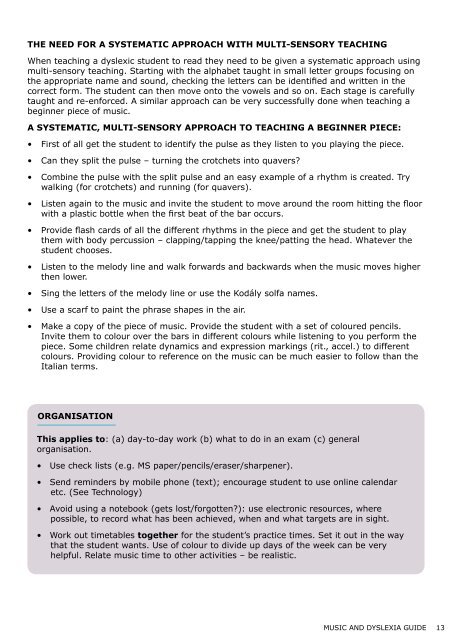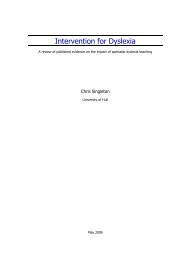TEACHER GUIDE TO MUSIC AND DYSLEXIA - Rhinegold Publishing
TEACHER GUIDE TO MUSIC AND DYSLEXIA - Rhinegold Publishing
TEACHER GUIDE TO MUSIC AND DYSLEXIA - Rhinegold Publishing
Create successful ePaper yourself
Turn your PDF publications into a flip-book with our unique Google optimized e-Paper software.
The need for a systematic approach with multi-sensory teachingWhen teaching a dyslexic student to read they need to be given a systematic approach usingmulti-sensory teaching. Starting with the alphabet taught in small letter groups focusing onthe appropriate name and sound, checking the letters can be identified and written in thecorrect form. The student can then move onto the vowels and so on. Each stage is carefullytaught and re-enforced. A similar approach can be very successfully done when teaching abeginner piece of music.A systematic, multi-sensory approach to teaching a beginner piece:• First of all get the student to identify the pulse as they listen to you playing the piece.• Can they split the pulse – turning the crotchets into quavers?• Combine the pulse with the split pulse and an easy example of a rhythm is created. Trywalking (for crotchets) and running (for quavers).• Listen again to the music and invite the student to move around the room hitting the floorwith a plastic bottle when the first beat of the bar occurs.• Provide flash cards of all the different rhythms in the piece and get the student to playthem with body percussion – clapping/tapping the knee/patting the head. Whatever thestudent chooses.• Listen to the melody line and walk forwards and backwards when the music moves higherthen lower.• Sing the letters of the melody line or use the Kodály solfa names.• Use a scarf to paint the phrase shapes in the air.• Make a copy of the piece of music. Provide the student with a set of coloured pencils.Invite them to colour over the bars in different colours while listening to you perform thepiece. Some children relate dynamics and expression markings (rit., accel.) to differentcolours. Providing colour to reference on the music can be much easier to follow than theItalian terms.OrganisationThis applies to: (a) day-to-day work (b) what to do in an exam (c) generalorganisation.• Use check lists (e.g. MS paper/pencils/eraser/sharpener).• Send reminders by mobile phone (text); encourage student to use online calendaretc. (See Technology)• Avoid using a notebook (gets lost/forgotten?): use electronic resources, wherepossible, to record what has been achieved, when and what targets are in sight.Work out timetables• together for the student’s practice times. Set it out in the waythat the student wants. Use of colour to divide up days of the week can be veryhelpful. Relate music time to other activities – be realistic.<strong>MUSIC</strong> <strong>AND</strong> <strong>DYSLEXIA</strong> <strong>GUIDE</strong> 13









